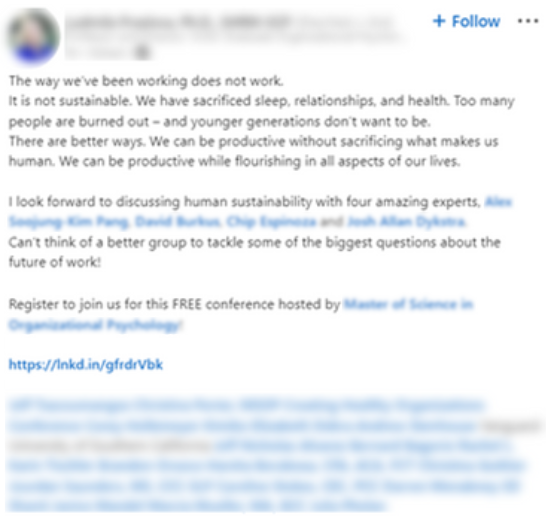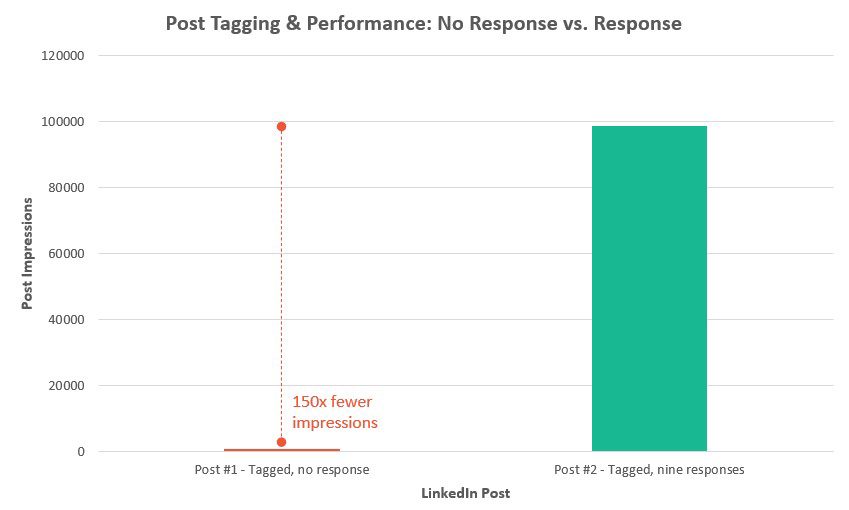
It seems the ‘reposting revelation’ from our last newsletter really struck a chord with you all. (Click this link to catch up if you missed it.) I’m so glad to hear it was helpful!
Because of that, I want to stay in the practical, myth busting space today, and hone in on yet another LinkedIn tactic that’s incredibly common among executive
s. One that few realise is doing significant damage to their reach and impact…
Yes – tagging.
Good and bad tagging: what’s the difference?

(The blurred elements in the above post are ALL names – 30 tagged individuals in total…)
Don’t get me wrong – I’m a huge fan of tagging (i.e. using the @ symbol to tag a person or entity on LinkedIn) when done the right way. It’s a fantastic way to alert key people to an issue, spark conversation, and generate engagement that extends post reach.
But – like reposting – it can truly torpedo post performance when used the wrong way.
What sort of tagging creates problems? Here are a few common scenarios:
- You tag your whole executive team at the end of your post as a sort of ‘FYI’ for a major campaign or event, but not everyone engages;
- You tag your team as a way to ensure equal acknowledgement of their efforts, but not all of them are active on LinkedIn;
- You tag a key prospect, partner, candidate or influencer (Simon Sinek, anyone?!) hoping to get on their radar, but they don’t engage; or
- You tag a Company page (e.g. corporation or publisher) to say thanks for interviewing you or hosting you at an event, but they don’t engage.
In each of these scenarios, if the tagged people or entities don’t reciprocate, LinkedIn treats your tagging as ‘fishing for engagement’ and post performance suffers. Often in two ways:
The ‘offending’ post fails to generate reach almost immediately; and (more worryingly…)
If repeated, fewer and fewer people will start to see and interact with every subsequent post of yours over time.
How bad can it get…?
Here’s my own experience.

A little while ago, I tagged an executive in a post I made. I didn’t know them, but it was a fair tag given the context. They didn’t reciprocate.
Within two weeks I made a separate post, tagging nine executives. All but one reciprocated.
The difference in performance? (See graph below.)
The second post generated over 150x more impressions than the first.
Tagging can be incredibly effective, but it must be done right.

Three ways to avoid risk and access better performance. While it’s extremely unlikely you’re trying to ‘doctor the system’, sadly the algorithm isn’t assessing your intent – just the actions you take.
So, what are some better, smarter approaches you can take to avoid the risk and get a better result?
1. If in doubt, don’t tag.
If you ever go to tag someone and think ‘They probably won’t reply…’ or ‘They’re rarely active on LinkedIn…’ – don’t tag them. It’s that simple. Your post performance will greatly improve, and you limit the risk of people missing key messages in the future.
2. Look for a private option vs. tagging publicly.
If you still want that person to notice but don’t want to shoot your post performance in the foot, try posting and then either: a) sending them a link to the post as a private message, using it as a way to start a conversation without pressuring them to reply publicly; or b) sending them a link to the post on email.
Particularly in the situation where you’ve previously tagged the whole executive team, far better to coordinate engagement behind the scenes on email than cannibalise performance on LinkedIn. Your posts will look less pre-prepared too.
3. Engage ahead of time.
This third approach might surprise you.
When the focus is on the message going out, it’s easy to miss other opportunities. Like undervaluing the power of participation and engaging with others’ content ahead of time.
Rather than tagging the same people in your post, think ahead of time and identify your ‘LinkedIn VIPs’. These are the small handful of people who do (or will) have the greatest impact on the success of your post. They may be the end target, an industry expert, or someone who will help your message reach the right people. Earmark them ahead of time, follow or connect with them, and interact with their content in the lead up to your post.
Why does this matter?
When you come to make any major announcement on LinkedIn and want key people to see them, it’s your pre-post engagement that will likely determine success. Your lead up efforts will also show them you’re interested in their work, and pop your face on their radar.
Win – win.
Use EOFY to reset your LinkedIn approach.
If your goals for next financial year are all about driving reach and awareness with new investors, building trust and rapport with candidates, or accessing partners beyond your current networks, use this opportunity to reset. The end of the financial year is a perfect time to review and refine any habits that might be limiting your impact.
Drop me a note if you’d value an audit on where you are today, and what you can do to improve performance – my goal is to ensure you get maximum return on your LinkedIn efforts, and to see good leadership amplified. I’d love to help.
Hopefully this advice has been helpful in the meantime, and I look forward to hearing your own thoughts and reflections.
Roge

Want more just like this delivered straight to your inbox? Subscribe below for all your latest digital reputation advice, trends and the best practice examples of the leaders getting it right online. We’d love to have you part of this growing community.